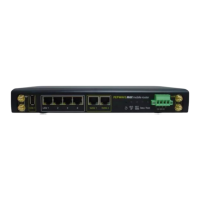The Port setting specifies the port(s) that correspond to the service, and can be configured
to behave in one of the following manners:
Any Port, Single Port, Port Range and Port Map
Any Port: All traffic that is received by Pepwave MAX via the specified protocol is
forwarded to the servers specified by the Servers setting.
For example, with IP Protocol set to TCP, and Port set to Any Port, all TCP traffic is
forwarded to the configured servers.
Single Port: Traffic that is received by Pepwave MAX via the specified protocol at the
specified port is forwarded via the same port to the servers specified by the Servers
setting.
For example, with IP Protocol set to TCP, and Port set to Single Port and Service Port
80, TCP traffic received on Port 80 is forwarded to the configured servers via Port 80.
Port Range: Traffic that is received by Pepwave MAX via the specified protocol at the
specified port range is forwarded via the same respective ports to the LAN hosts specified
by the Servers setting.
For example, with IP Protocol set to TCP, and Port set to Single Port and Service Port
80-88, TCP traffic received on ports 80 through 88 is forwarded to the configured servers
via the respective ports.
Port Mapping: Traffic that is received by Pepwave MAX via the specified protocol at the
specified port is forwarded via a different port to the servers specified by the Servers
setting.
For example, with IP Protocol set to TCP, and Port set to Port Map, Service Port 80, and
Map to Port 88, TCP traffic on Port 80 is forwarded to the configured servers via Port 88.
(Please see below for details on the Servers setting.)
Range Mapping: traffic that is received by Pepwave MAX via the specified protocol at the
specified port range is forwarded via a different port to the servers specified by the
Servers setting.

